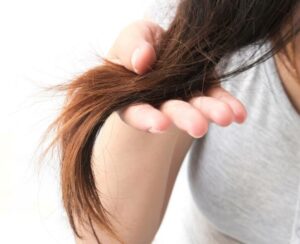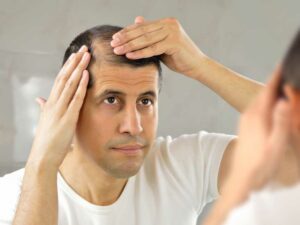Introduction:
Hair loss, a common affliction of humans, occurs in many pathophysiological conditions of the skin as well as in systemic disorders. Classification of hair loss is commonly divided into two categories, cicatricial (scarring) and noncicatricial alopecia. Gicatuicial alopecia results from hair follicle damage complicated by various pathological changes of the surrounding skin, Noncicatricial alopecia is caused by either functional or structural disorders of the hair follicle itself. This latter condition may be further divided into primary and secondary causes. Secondary follicular disorders are usually the result of chemotherapy or physical (radiation) treatment of cancers, nutritional and hormonal disorders, or stress. Although the cause and pathogenetic backgrounds of primary noncicatricial alopecia are largely unknown, this refractory and mostly irreversible hair loss has been a major therapeutic challenge for the dermatologists. Male pattern alopecia (andro genetic alopecia) and alopecia aceata are the most common afflictions in this form of hair loss. An understanding of the normal structural features of the anagen follicle and of the hair follicle cycle is needed for a study of the abnormal changes involved in the histopathology of alopecia. Knowledge of the dynamic processes of the hair follicle cycle is also important in understanding the pathogenesis of the alopecias and the fate of abnormal follicles and to understand the prognosis and the indications for therapeutic challenges with various medications, Thus, the unique process of follicular cyclic growth will first be described, and a possible role of cyclic growth in development of male pattern baldness will be discussed. Some analogies between the normal hair cycle and the development of dystrophic follicles in patients with alopecia areata will also be described.
Hair Loss and Hair Follicle Abnormality:
The myriad hairs growing on the human body are products of subcutaneous mico-organs called hair follicles. Regardless of the length and thickness of the shaft, each individual hair grows to a single hair follicle. The size of the hair follicle determines the thickness and relative length of the hair shaft: long, coarse terminal hairs are produced from large terminal follicles and short, fine hairs from small vellus follicles. Under healthy conditions the normal pattern of body hair growth is generally well maintained topographically by the characteristically distributed terminal and vellus follicles. However, abnormal conditions, such as hormonal disorders, inflammations, toxic exposures, and stress that cause abnormal changes of the hair follicles readily induce either gradual thinning or rapid loss of hairs in the body.
The loss of scalp hair is a most conspicuous phenomenon; it may appear as a complete loss of the hair shaft in patchy and wide scalp regions, a reduced density of terminal hair, or a replacement of terminal hairs with vellus hairs. A complete loss of scalp hair is usually caused by severe dystrophic or degenerative changes of hair follicles due to toxic or inflammatory processes resulting in alopecia areata, alopecia totalis, or alopecia universalis. Reduced density of the terminal hairs (thinning) in the vertex or frontal edge of the scalp is a common feature of female alopecia. The thinning of scalp hairs concomitant with a replacement by vellus hairs is typical of male pattern baldness (androgenetic alopecia). Unlike complete hair loss caused by hair follicle damage, female alopecia and male pattern baldness usually lack either degenerative changes of the hair follicles per so or abnormalities of the surrounding tissues. However, dystrophic hair follicles are frequently found in the long-standing, advanced bald scalp, particularly in aged subjects. The thinning of hair in both female and male common baldness is known to result from a diminution of the size of hair follicles. The magnitude of this follicular diminution is much greater in male than in female alopecia.
Thus, the simple phenomenon of “hair loss” involves many different changes occurring underneath the skin, particularly changes of the hair follicle structures. Knowledge of the different hair follicle abnormalities that cause the syndrome of hair loss makes it possible to determine the nature of the disorder, to predict the prognosis, and to select the treatment. The structure of hair follicles consists of highly differentiated multi-compartmental cell groups. This independent “micro-organ” in the skin not only continuously manufactures hair but also undergoes a complete remodeling of its structure in continuous periodic cycles. Synchronization of these cycles with seasonal changes occurs in many animals: the products of newly remodeled follicles in each cycle are their winter or summer coats.” Thus, the cyclic change of hair follicles not only brings a replacement of an old hair with new but also can alter the length, thickness, and color of new hair. However, the cyclic turnover of human hair follicles shows an asynchronous pattern; each follicle has a different time of cyclic onset. In addition, the time for total cyclic turnover varies among the follicles of different size and those in different body regions. Nonetheless, this periodic structural remodeling of the hair follicles – from a growing (anagen) to resting (telogen) and again to new growing phases – is essential for the developmental growth and maintenance of hair as well as for the process of hair loss and for its repair. Therefore, before describing the various pathological conditions of “hair loss” the next section will review the normal structure of hair follicles as well as the dynamic process of the hair follicle cycle.
The Structure and Cyclic Growth of the Hair Follicle:
The structure of hair follicles differs at different phases of the hair cycle. The anagen phase follicle, with a characteristic bulbar structure, is usually represented as the typical follicular structure because of its active hair production. However, the telogen (resting) follicle, which consists of a rather simple epidermal sac, is also important, since it holds old hair until a new hair grows out through the same pilacy canal. The telogen follicles also play a far more important role: they carry over the follicular germ cells from one cycle to the next and become an anchoring base for the new anagen follicle being formed by the germ cells. The follicles can transform their size, and damaged hair follicles can be repaired during the reproductive phase. Thus, the dynamics of the hair follicle cycle and the structural characteristics of the cyclic phases are the keys to the development of normal hair and to abnormal hair loss.
The cyclic follicular growth in postnatal life is actually an inheritance of embryonic folliculo genesis. This cyclic cytoarchitectural remodeling that begins in the early fetal skin and virtually lasts for the entire life span is unique among the postnatal organs. To gain an overview of the cyclic growth of hair follicles, let us begin by looking at embryonic folliculogenesis in human fetal skin.
Fetal Folliculogenesis:
Primary hair follicles of the upper lip, eyebrows, and chin develop from the embryonic epidermis as early as the ninth week of gestation. Generally, folliculogenesis in the scalp and most other body regions appears about the fourth month of gestation. Interestingly, in back and scalp skin, the development of hair follicle germ cells from the epidermis and the continuous growth of follicular structure are not synchronized. In Figure 1a, each of the five primary follicles seen in back skin of a human fetus at the fourth month of gestation shows a different stage of development. This mosaic pattern of fetal folliculogenesis is also found in the scalp skin, and some follicles show fully developed anagen structure, forming a hair (Figure 1b). Asynchronization of the hair cycles in the skin of humans and many mammals may result from this random onset of primary folliculogenesis in the fetal skin. The first distinctive formation of the hair follicle germ (hair germ) cells occurs as a nodular proliferation of the epidermis concomitant with an aggregation of the dermal meson- chymal (fibroblastic) cells (Figures 2a,b). This harmonious proliferation of the epidermal cells (follicular epithelial cells) and mesenchymal cells (some of which become dermal papilla) is not only a characteristic feature in fetal folliculo genesis but also appears in cyclic follicular growth during the entire life span. Furthermore, specialized mesenchymal cells are known to play a role as inductive organizers of both fetal and postnatal folliculogenesis. Continued pro liferation of the epidermal cells and mesenchy mal cells forms an elongated thick stalk in the dermis called a follicular (hair) peg (Figure 2c). The mesenchymal cells surround the entire follicular peg and partially aggregate in the tip of the peg. While downward growth of the follicular peg continues, differentiation of follicular cells forms the primordial bulbar, sheath, and sebaceous glandular structures (Figure 2d). In this bulbous peg stage, the partially keratinized hair matrix appears in the suprabulbar region. The mesenchymal cells in the bottom of the peg are engulfed by the bulbar matrix cells and begin to occupy the dermal papilla. Some mesenchymal cells remain in the perifollicular regions and become the perifollicolar sheath and a crescent cap in the bottom of the follicle (Figure 2d). Differentiation of the follicular cells continues in the peg and leads to complete formation of a growing anagen follicle, which produces a hair (Figure lb). These developmental stages of fetal follicologenesis that begin as a proliferation of epidermal cells and eventually form a complex multi-compactmental hair follicle are all seen in the cyclic growth of postnatal hair follicles. In the postnatal follicular growth cycle, an appear once of the follicular germ cells (Figure 2a) in the base of a telogen (resting) follicle first develops to a follicular peg, then to a bulbous peg, and finally to a complete anagen follicle. This wide- ranging potential of follicular germinal cells apparently remains from the fetal period through an entire life span.
Figure 1 Primary folliculogenesis in fetal skin
Primary follicologenesis in the back of a 4-month-old fetal skin showing a follicular germ (arrow), 3 follicular pegs (middle), a bulbous peg (right) (a), and a primary anages with formation of hair and sebaceous gland (b).
Figure 2 Stages of primary follicles
Magnified view of different stages of primary follicles. Follicular germs consisting of proliferated epidermal basal cells with aggregation of dermal mesenchymal cells (a,b), a follicular peg showing an elongation of undifferentiated follicular epithelial cells with dense aggregation of dermal papilla cells and perifollicular sheath of dermal cells (c), a bulbous peg forming a primordial bulb with dermal papilla, partially keratinized cuticle cells, and inner and outer root sheath(Id). Fp = follicular germs = follicular peg, Me = mesenchymal cells, D = dermal cells, Dp = dermal papilla, Ct = cuticle cells, I = inner root sheath, 0 = outer root sheath.
Cyclic Growth of the Hair Follicle:
The lanugo (fetal) hairs grown in the torso and extremities of the fetal body are shed during the fetal life after the primary hair follicles develop in the fetal skin; This fact demonstrates that cyclic growth of hair follicles is already under- way in the fetal skin. However, the scalp hair follicle cycle does not begin until the neonatal period. This topographical difference of the timing of the follicular cycle between the scalp and other body regions appears to be genetically coded in the follicular cells during the primary folliculogenesis. A second difference is reflected in the fact that the scalp hairs grow much longer and thicker than the hairs in other body regions during fetal as well as postnatal life. Scalp hair follicles have a longer anagen phase than the follicles in other body regions. The genetic factors determining the length of the anagen phase seem to stop the mitotic proliferation of the bulbar matrix cells and concomitantly activate the perifolliculac mesenchymal cells that serve to absorb the follicular structure during the catagen phase. As seen in the diagrams of Figure 3, a growth cycle ends when an anagen follicle undergoes catagenic induction. Regardless of the size of the follicles (vellus or terminal) and regardless of the body location of the follicles, the structural features of cyclic growth exhibit the same characteristic patterns.
Growing Anagen Phase
In structure and function the anagen follicle is virtually an independent factory that manufactures hair, maintains its own sheath, and stores the basic energy supply. The long, tube-like structure, whose one end opens to the skin surface and the other reaches to the subcutaneous fat tissue, is divided into the upper and lower sheath. The upper sheath consists of multilayered epidermal cells and forms the pilary canal. Ducts for sebaceous glands and apoccine sweat glands open into the pilary canal. The lower margin of the upper sheath is located at the level where the arrector pili muscle inserts into the sheath. This portion of the follicle almost permanently retains its structure, even during the catagen phase: the cyclic remodeling of a hair follicle normally occurs only in the structure below the upper sheath. Therefore, the follicular accessory structures, such us the sebaceous gland, arrector pili muscle, duct of apocrine gland, and follicular sensory nerve endings (palisade or circular endings), ace not involved in the cyclic change of the hair follicle. The part of the telogen follicle consisting of the upper sheath per so and all accessory structures in the pili sebaceous unit remains unchanged (Figure 4).
Figure 3 Growth cycle of hair follicle
The lower sheath, including the bulb of the hair follicle, is a characteristic structure of an anagen follicle. The pluripotential germ cells are seeded in the hair follicle from the time of primary folliculogenesis and are carried over during each cyclic turnover, apparently in the basal portion of the bulb. The follicular germ cells, now referred to as bulbar matrix cells, show a great potential for mitotic proliferation (Figure 5). The cells proliferate in the bulbar matrix and show an upward migration and immediate differentiation into the three major groups: hair matrix, inner sheath, and outer sheath (Figure 5). The hair matrix group is located in the central axis and further differentiates into the cells forming the medulla, hair cortex, and hair cuticle. Continuous upward migration of these cells and keratinization of the cortical and cuticle cells constitute the essential manufacturing process of hair in an anagen follicle. The inner sheath cells differentiate to Henle and Huxley cells, and they eventually keratinize to make the inner wall of the pilary canal, The cells located at the outer wall of the bulb and lower follicular structure differentiate to cuboidal shaped cells and accumulate a large amount of glycogen in their cytoplasm (Figure 5). The glycogen in the outer root sheath is thought to be utilized for a local supply of energy and materials for bulbar cell activities. The melanocytes that produce melanin pigments for the hair cortex are located in the follicular bulb, these typical dendritic cells, containing brown to black pigments, are usually scattered along the inner edge of the bulbar cells close to the dermal papilla (Figure 7). The melanocytes residing in the bulb do not move, but their products, melanin pigments, are exported from the melanocytes and transported into the hair cortical cells (Figure 8). The dermal papilla surrounded by the bulbar epithelial cells contains primarily fibrocytic cells and blood vessels. During the anagen phase, this structure appears to serve as an entry port for blood circulation and dermal ground substance. However, the mesenchymal cells in the dermal papilla appear to have some influence in bulbar cell differentiation. The metamorphosis of these fibrocytic cells to premature types of mesenchymal cells occurs during the catagen phase. This type of mesenchymal cell always coexists in the vicinity of the follicular germinal cells in fetal folliculogenesis and post natal follicular growth (Figures 2a,b).Jahoda et al found that transplantation of the isolated dermal papilla cells into the oral mucosa induced a follicular neogenesis in adult rats. The dermal papilla cells are thus an important component of the hair follicle, and an interaction between the follicular epithelial cells and mesonchymal cells plays an essential role in follicular cyclic growth.
Figure 4 Anagen and telogen follicles
An anagen follicle (left) showing a long and stretched lower follicle in the dermal adipose tissue. A telogen follicle (right) consisting of the upper follicular sheath above the level of insertion of an arrector pili muscle.
Figure 5 Lower sheath and bulb of anagen follicle
The lower follicular sheath and bulb of an anagen follicle showing many mitotic cells (arrows and PNA-synthesizing cells shown in an inserted autoradiographic picture, upper right) in the bulbar matrix cells, dermal papilla, melanocyles (arrowheads), prekeratinized hair cortical cells, and inner and outer root sheath. Pp = dermal papilla, Hc = hair cortical cells, I = inner root sheath, 0 = outer root sheath.
Figure 6 Anagen follicle: Bulb and suprabulbar portion
The bulb and suprabulbar portion of an anagen follicle. Arrows indicate the matrix cell differentiation to enter and inner root sheath, hair cortex, and hair medulla cells. 0 = outer root sheath, I = inner roof sheath, C = hair cortex, M = medulla cells.
Figure 7 Anagen follicle bulb showing melanocytes and melanin
The bulb of an anagen follicle containing many dendritic melanocytes with dark melanin pigments (arrows).
Figure 8 Melanin pigments in melanocyte and cortical cells
Many dark pigmented melanocytes located in the bulb (arrows) and transferred melanin pigments from the melanocytes to the hair cortical cells (arrowheads).
Catagen Phase
Although the triggering mechanism that induces catagen is not known, experimental drugs that inhibit mitosis – such as cyclophosphamide and colchicine – can induce premature catagen phase in anagen follicles. Radiation, which causes degeneration of the lower follicular structures, is also known to arrest the anagen phase. Hollis et al reported an interesting study on the catagenic induction of sheep hair follicles by the intra- venous infusion of mouse epidermal growth factor. They observed sequential microscopic changes in hair follicles that appear to be similar to the changes that occur naturally during the transition to the catagen phase. This work suggests that the process involves a well-organized autophagy (suicidal self-absorption) of the follicular epithelial cells. The bulbar cells, which produce hair matrix and highly differentiated inner and outer root cells, all disappear for a short time (approximately one week). Then proliferated perifollicular connective tissue cells and a thick proteinaceous hyaline membrane (vitreous membrane) surround the epidermal cell cord remaining in the center of mid-catagen follicles (Figures 9a,b). Further, the autophagic change of the follicular epidermal cells and the absorptive action of the connective tissue cells phagocytize the whole lower follicular structure (Figure 9c). The dermal papilla cells are not involved in the absorptive process, they show a metamorphosis to a rather undifferentiated type of mesenchymal cell (Figure 9b). These mesenchymal cells are comparable to the cells seen in fetal folliculogenesis (Figure 2). At the end of the follicular catagen stage the cells begin to disperse into the perifollicular connective tissue cells (Figure 9c). However, these mesenchymal cells seem to be retained in the vicinity of follicles throughout the telogen stage, and they proliferate again when the follicular germ cells begin to grow in early anagen follicles.
Telogen Phase
During catagen, a hair produced in the anagen bulb remains in the upper follicular sheath, and the lower tip of the keratinized hair cortex is tightly attached to the epidermal cells of the upper follicular sheath. This club hair does not shed until a new hair emerges from a new anagen follicle, The telogen follicles consist of simple epidermal sheaths and serve not only to hold the hair but also to anchor the base of a new anagen follicle. Cyclic remodeling occurs only in the structure below the upper follicular margin.
Figure 9 Follicular changes of the catagen phase
A catagen follicle showing the disappearance of the inner and outer root sheath, hair matrix, and bulbar structure, and the remaining epithelial stalk surrounded by a thick hyaline membrane and proliferated perifollicular cells (a), magnified view of absorptive epithelial stalk by proliferated perifollicular cells (b), near end stage of catagen stage, degeneration and shrinkage of the epithelial stalk and many proliferated perifollicular cells, and migration of the dermal papilla cells to the dermis (c). Ep = epithelial stalk, Pp = dermal papilla, Ch = club hair Pt = perifolliculer cells.
Thus, the pilary canal consisting of part of a telogen follicle remains as a static structure for the individual’s entire life span (Figure 10). The average duration of the telogen (resting) phase varies greatly in the body region, face, extremities, and scalp. This regional variation in the cyclic interval differs from person to person within different sex, ethnic, and age groups.
Early anti Mid-anagen Phase
The follicular germ cells that remain inert during the telogen phase begin to grow in the base of telogen follicles during transition from the telogen to the early anagen phase. An aggregation of mesenchymal cells is always seen below the follicular peg (Figure 11). Mitotic cell proliferation and occasional appearance of melanocytes are found in the growing peg. By mid anagen stage the formation of a new bulbar structure begins in the elongated follicular peg. This primordial follicle starts to produce a new hair matrix and an inner and outer root sheath that connects with the anchoring telogen follicle (Figure 12).
Figure 10 Telogen follicle
A telogen follicle showing simple epidermal cells engulfing a club hair Ch = club hair
The potential for variation of follicular germ cell growth in early to mid-anagen follicles is a determining factor for follicular transformation; an increased rate of cell proliferation in the germinal cells produces a larger primordial follicle and a larger new anagen follicle than that produced in the previous cycle. Any hormones or agents influencing the rate of mitotic proliferation during these cyclic phases induce either enlargement or diminution of a new anagen follicle. Thickening or thinning of the hair caliber is a result of follicular transformation from vellus to terminal or vice versa. The new anagen follicle continues its down- ward elongation and the now hair and follicular sheath merge into the lateral wall of the telogen follicle (Figure 13). Then, the new pilary canal of the anagen follicle perforates the pilary canal of a club hair (Figure 14). Finally, both the new hair from the fully developed anagen follicle and the club hair in the anchoring telogen follicle emerge from the skin surface through the same pilary canal (Figure 15). Subsequently, the wall of the telogen follicle merges into the upper follicular sheath of the new anagen follicle and the club hair is shed. Thus, a replacement of old hair with new hair by cyclic turnover usually occurs without loss of hair.
Figure 11 Early anagen follicle
An early anagen follicle associated with proliferated follicular germinal cells and dermal mexenchymal cells. Mitotic cells (arrow). Pp = follicular germinal cells, Me = mesenchymal cells.
Figure 12 Mid-anagen follicle
A mid-anagen follicle showing a formation of primordial anagen bulbar structure with hair matrix, inner and outer root sheath, and bulb engulfing dermal papilla cells. B = bulbar structure, Hm = hair matrix, I = inner root sheath, 0 = outer root sheath, Pp = dermal papilla.
Figure 13 Merger of new anagen follicle with telogen follicle
A new anagen follicle merging its upper follicular wall into an anchoring telogen follicle, club hair, new hair. T = telogen follicle, Ch = club hair, H = new hair
Figure 14 New anagen follicle pilary canal perforating club hair canal
A new anagen follicle perforating its pilary canal into a club hair canal (arrow).







